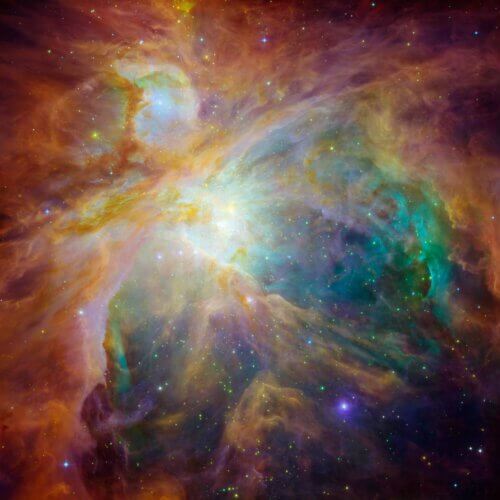Gaseous swirls of hydrogen, sulfur and hydrocarbons cradle a collection of baby stars in this composite image of the Orio Nebula as seen by the Hubble Space Telescope and the Spitzer Space Telescope

Gaseous swirls of hydrogen, sulfur, and hydrocarbons cradle a collection of baby stars in this composite image of the Orion Nebula (also known as M42 or NGC 1976), as seen by the Hubble Space Telescope and the Spitzer Space Telescope. Together the two telescopes detect carbon-rich molecules in the cosmic cloud in this star-forming factory 1,500 light-years away.
Hubble's ultraviolet and visible light view reveals hydrogen and sulfur gas that have been heated and ionized by strong ultraviolet radiation from the massive stars, collectively called the "Trapezoid." At the same time, Spitzer's infrared view reveals carbon-rich molecules in the cloud. Together, the telescopes reveal the stars in Orion as a rainbow of dots scattered throughout the image.
The Orion Nebula (in English: Orion Nebula) or the Great Nebula of Orion (The Great Nebula of Orion) is an impressive scattered nebula in the Orion constellation. The nebula, also called the "Queen of Nebulae", is about 1,300 light years away from the solar system. It is an emission, return and absorption nebula, and its size is estimated at 24 light years.
The closest star forming region to the solar system
The nebula is located south of Orion's "Belt" in the center of the "Sword". From a dark place it can be seen with the naked eye as a hazy spot. Binoculars held on a stable base will reveal the characteristic flower configuration of this nebula, and the wealth of impressive details begins to be revealed already with the help of an amateur telescope. The Orion Nebula is one of the most studied objects by professional astronomers, and one of the most observed targets with research telescopes.
The Orion Nebula is the brightest bone in the hunter's sword in the group. The Cosmic Cloud is also the closest star-making factory and astronomers suspect that it has about a thousand young stars. The Orion group is viewable in autumn and winter from northern latitudes. The nebula itself is not visible but can be viewed through binoculars or small telescopes.
For information on the NASA website (As part of the NASA Photo of the Day section on December 31, 2020, although it is an old photo)
More of the topic in Hayadan:

One response
Orion had a dog named Sirius, after a name from Medina in the north of Israel.